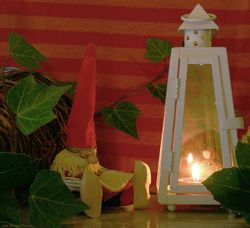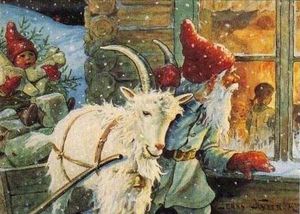A tomte ['tɔ`m:tɛ] or nisse ['nìs:ɛ] is a mythical creature of Scandinavian folklore, believed to take care of a farmer's home and barn and protect it from misfortune, in particular at night, when the housefolk were asleep. Tomte is the common Swedish name, derived from his place of residence and area of influence: the house lot or tomt. The Finnish name for him is "tonttu". Nisse is the common name in Norwegian, Danish and the Scanian dialect in southernmost Sweden; it is a nickname for Nils, and its usage in folklore comes from expressions such as Nisse god dreng ("Nisse good lad," cf. Robin Goodfellow).
Contents |
Appearance
Temperament
Despite his smallness, the tomte/nisse possessed an immense strength. Even though he was protective and caring he was easy to offend, and his retributions ranged from a stout box on the ears to the killing of livestock or ruining of the farm's fortune. The tomte/nisse was a traditionalist who did not like changes in the way things were done at the farm. Another easy way to offend him was rudeness: farm workers swearing, urinating in the barns, or not treating the creatures well would be soundly thrashed. If anyone spilled something on the floor in the house it was wise to shout a warning to the tomte below. An angry tomte is featured in the popular children's book by Swedish author Selma Lagerlöf, Nils Holgerssons underbara resa genom Sverige (Nils Holgersson's Wonderful Journey Through Sweden). The tomte turns the naughty boy Nils into a tomte in the beginning of the book, and Nils then travels across Sweden on the back of a goose.
Like many other mythical creatures, one was also required to please him with gifts – a particular gift was a bowl of porridge on Christmas night. If he wasn't given his payment, he would leave the farm or house, or engage in mischief such as tying the cows' tails together in the barn, turning objects upside-down, and breaking things (like a troll). The tomte liked his porridge with a pat of butter on the top. In an often retold story, a farmer put the butter underneath the porridge. When the tomte of his farmstead found that the butter was missing, he was filled with rage and killed the cow resting in the barn. But, as he thus became hungry, he went back to his porridge and ate it, and so found the butter at the bottom of the bowl. Full of grief, he then hurried to search the lands to find another farmer with an identical cow, and replaced the former with the latter.
The tomte is connected to farm animals in general, but his most treasured animal was the horse. Belief had it that you could see which horse was the tomte's favourite as it would be especially well taken care of and healthy. Sometimes the tomte would even braid its hair and tail. (These "tomte braids" were in fact most likely caused by insufficient brushing.) Sometimes actually undoing these braids could mean misfortune or angering The tomte.
The heathen tomte
The tomte was in ancient times believed to be the "soul" of the first inhabitor of the farm. He who cleared the tomt. He had his dwellings in the burial mounds on the farm, hence the now somewhat archaic Swedish names tomtebisse and tomtekarl, Swedish and Norwegian names tomtegubbe, and the Finnish name tonttu-ukko (litt. House lot man) tomtebonde (bonde=farmer) and the Norwegian Haugkall (Mound man). Thus can the tradition of giving porridge to the tomte at Christmas be a reminescence of ancestral worship.
The belief in a tomte's tendency to bring riches to the farm by his unseen work could also be dragged into the conflicts between neighbours. If one farmer was doing far better for himself than the others, someone might say that it was because of him having tomtar on the farm, doing ungodly work and stealing from the neighbours. These rumours could be very damaging for the farmer who found himself accused..
Similar folklore
The tomte/nisse shares many aspects with other Scandinavian wights such as the Swedish vättar (from the Old Norse "landvættir") or the Norwegian tusser. These beings are social, however, whereas the tomte is always solitary (though he is now often pictured with other tomtar). Some synonyms of tomte in Swedish and Norwegian include gårdbo ((farm)yard-dweller) gardvord (yard-warden, see vörðr) god bonde (good farmer) fjøsnisse (barn gnome) or gårdsrå (yard-spirit). The tomte could also take a ship for his home, and was then known as a skeppstomte/skibsnisse. In other European folklore, there are many beings similar to the tomte, such as the Scots brownie, the German Wichtelmann or the Russian domovoi. The Finnish word tonttu has been borrowed from Swedish.
The tomte is one of the most familiar creatures of Scandinavian folklore, and he has appeared in many works of Scandinavian literature. With the romanticisation and collection of folklore during the 19th century, the tomte would gain popularity. In the English editions of the fairy tales of H. C. Andersen the word nisse has been inaccurately translated as "goblin" (a more accurate translation is "brownie").
The modern tomte

In the 1840's the farm's "nisse" became the bearer of Christmas presents in Denmark, and was then called "julenisse". In 1881, the Swedish magazine Ny Illustrerad Tidning published Viktor Rydberg's poem Tomten, where the tomte is alone awake in the cold Christmas night, pondering the mysteries of life and death. This poem featured the first painting by Jenny Nyström of this traditional Swedish mythical character which she turned into the white-bearded, red-capped friendly figure associated with Christmas ever since. Shortly afterwards, and obviously influenced by the emerging Father Christmas traditions as well as the new Danish tradition, a variant of the tomte/nisse, called the "jultomte" in Sweden and "julenisse" in Norway, started bringing the Christmas presents in Sweden and Norway, instead of the traditional julbock Yule Goat.
Gradually, commercialism has made him look more and more like the American Santa Claus hustomte to tidy up for them.
See alsoo
- Vår svenska tomte, Ebbe Schön (1996), ISBN 91-27-05573-6
External link
- Tomten, poem in Swedish by Viktor Rydberg
Categories: Christmas characters
Tomte, tomtar, swedish tomte, viktor rydberg tonttu, Christmas characters, food, holidays, music, Santa Claus, traditions, nightmare, music sheet, cards, decoration, tree, ornament, gift, light, song, shop tree, craft, stocking, artificial christmas tree, carol, heaven in, gift idea, party

